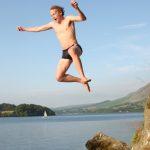
What are sneaker waves?
Also known as a sleeper wave, a sneaker wave is a disproportionately large coastal wave that can appear without warning.
A beach with big crashing waves (like the one pictured) is a safe beach in the sense that due warning is given of the power of the sea, and breaking waves are dissipating energy. Sneaker waves are dangerous because their force comes with little warning and they surge across beaches, knocking people over and dragging them out to sea.
They form as induced waves that are made by variation of average water height under the passage of groups of waves. When distant storms increase water height variation, beaches at the edge of deep sea are where sneaker waves can occur.
Can you get sneaker waves in Britain?
Around Britain and Ireland shallow seas – our deepest water is inland in Loch Morar – restrict induced waves from building into sneaker waves. Sneaker waves are a phenomenon to keep in mind when travelling to beaches that edge deep sea and have steep drop-offs. Reynisfjara, the famous black sand beach in Iceland, is prone to sneaker waves because of an underwater cliff.
Along America’s West Coast from California through Oregon and in Washington State, northwest and west facing beaches catch sneaker waves – here’s one caught on camera at Coos Bay, Oregon. So, when travelling keep in mind that wave behaviour on familiar beaches is not how waves work everywhere.
More ‘You Ask, We Answer’ stories at Outdoor Swimmer.








